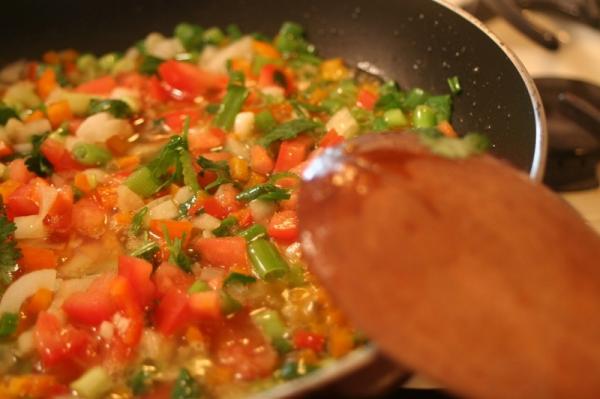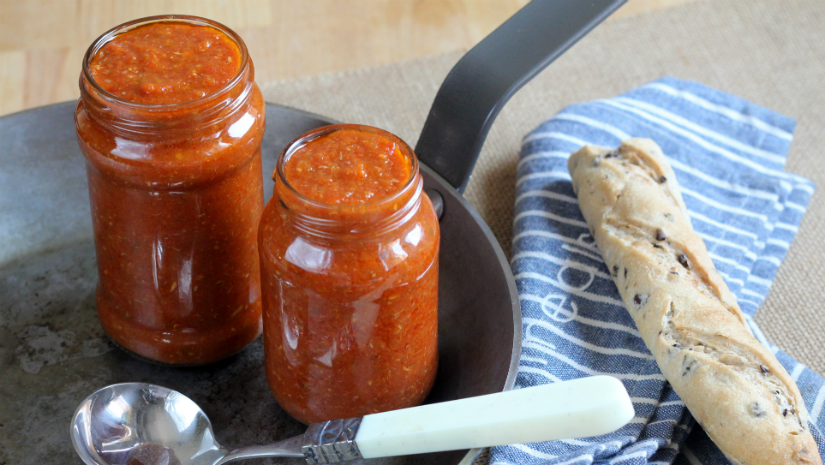
The latest study praising the virtues of the Mediterranean diet has come from Newcastle University. Researchers studied data from 60,000 people and found that eating plenty of fruit, vegetables, legumes, fish and olive oil, and very little red and processed meat could significantly cut your dementia risk.
Along with this, they suggested that to maximise the benefits of the Mediterranean way of life, we should be having twice weekly servings of sofrito – a simple sauce made from just four or five ingredients, that is the bedrock of Mediterranean cuisine, used in sauces, soups and stews, and as a marinade for fish and meat. The ingredients vary slightly by region, but it always starts with a base of staples: onions, tomatoes and olive oil. In Spain, it usually contains garlic and peppers, in Italy, celery and carrots.

Sofrito was also identified as a key component in the ‘perfect’ diet based on findings from an influential, long-running study conducted in Spain, which informed Newcastle University's research.
One of the crucial ingredients for brain health is plenty of olive oil, which is abundant in sofrito, and has a healthy profile of fats – mono and poly-unsaturated fatty acids. It’s also rich in polyphenols. There is some sound evidence now that these compounds contribute to the cardiovascular and cognitive benefits of the Mediterranean diet.
A diet that includes two dishes cooked with sofrito per week has broader health benefits, as it means that you’re cooking a healthy meal from scratch and not taking shortcuts or eating fast food according to nutritionists. But the tomato base provides a specific brain boost.
Tomatoes contain an antioxidant called lycopene that reduces what we call ‘free radical damage’ – the damage that the environment, our genes and lifestyle can have on our body – and reduces the risk of certain types of dementia. It’s lycopene that gives tomatoes their bright red colouring.
According to nutritionists what’s great about tomatoes is that the lycopene content increases and becomes more readily available to the body when it’s cooked. And you’ve lost the water so you've got a more concentrated source.
Some suggest that cooking tomatoes with olive oil – as is often the case in a Mediterranean diet – further increases the concentration of this potent antioxidant. An Italian study showed that the absorption of lycopene was three times greater from cooked tomatoes in comparison to raw.
Onions and garlic get their smell from allicin, another anti-inflammatory ingredient. Italian 'soffritto' typically also contains carrots and celery. Carrots contain beta-carotene, an antioxidant, and like the tomato, it’s more efficiently absorbed when it’s cooked. Beta-carotene, which is also present in tomatoes, helps support a healthy immune system.
How to make sofrito - Spanish style :
To make a good sofrito, generally, we will use garlic, onion, green pepper, tomatoes and ñoras or chorizo peppers.
To make the sauce, we will start by chopping the vegetables in brunoise and frying them over low heat in a pan with olive oil. If we are going to incorporate dried peppers or ñoras, we will leave them to soak in hot water to extract their flesh and incorporate it into the sauce as we will see later.

It is a matter of slowly poaching the ingredients, without browning them, since what interests us is the evaporation of the water content to intensify the flavour. In the process, we will be stirring from time to time until the vegetables are at the desired point. The secret to a good stir-fry is patience. Do not do this if you are in a rush.
Depending on the recipe you want to make we can add other ingredients such as aubergines, carrots or courgettes. We can also incorporate spices, and aromatic herbs such as thyme, rosemary, basil or parsley.
However, the essential ingredients of a stir-fry are garlic, onion and tomatoes. From there, your imagination sets the limit.
I recommend that you prepare a sauce with two or three large tomatoes, three cloves of garlic, a couple of large brown onions, a green pepper and two or three ñoras.
The first step is to sauté the onion, add the peppers and when everything is well sauteed, add the chopped tomatoes. It is better to do it this way because tomatoes release a lot of water. While they release it and evaporate it, we take the opportunity to remove the flesh from the ñoras or choriceros (chorizo peppers) that we will have soaked, incorporating the flesh into the sauce.
It is important to remember once again that the sauce must be done over low heat so that the vegetables reduce slowly. Once well poached, we can add some aromatic herbs, crushed garlic, parsley and saffron to the sauce, or simply blend it. If you have a moulin grater you can blend it down and remove the seeds and skin at the same time. The resulting texture of the blended sauce will be perfect. If you want it thicker, you can continue reducing it in the pan. Another trick here to intensify the flavour is to add some more water to the blend and reduce it again. You can do this a couple of times and it will intensify the sauce even further.
slowly. Once well poached, we can add some aromatic herbs, crushed garlic, parsley and saffron to the sauce, or simply blend it. If you have a moulin grater you can blend it down and remove the seeds and skin at the same time. The resulting texture of the blended sauce will be perfect. If you want it thicker, you can continue reducing it in the pan. Another trick here to intensify the flavour is to add some more water to the blend and reduce it again. You can do this a couple of times and it will intensify the sauce even further.

Finally, all that remains is to store our homemade sauce in small sterilized jars like when we make jams, to have it available for when we want to make anything with extra flavour. These jars can be frozen or sealed under a vacuum and can last several months in perfect conditions.